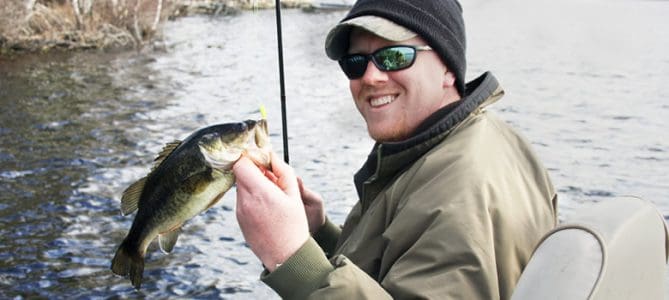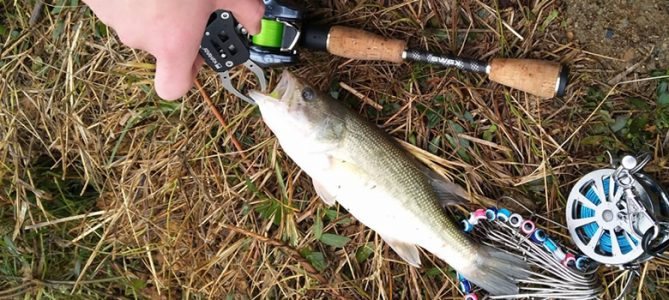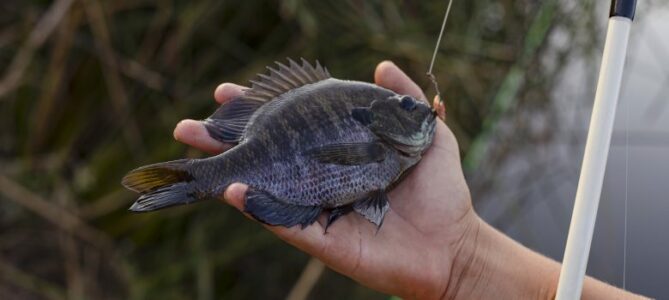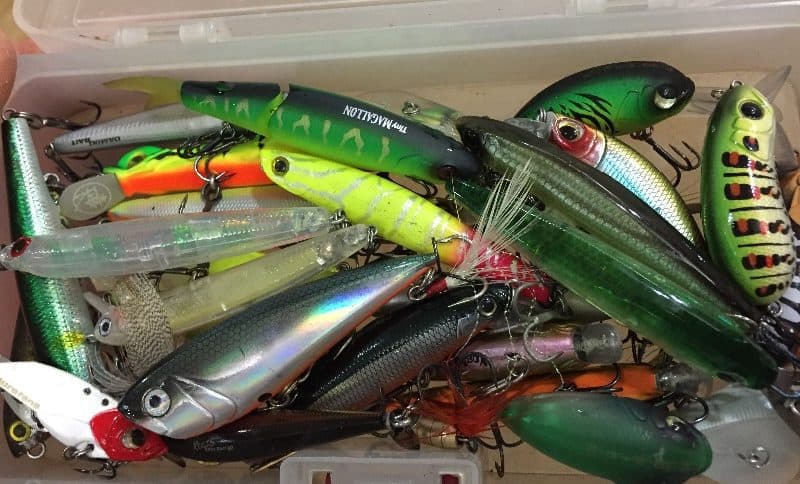If you buy via a link on this page, we may receive a commission, at no extra cost to you.Learn more
One bait type that many bass fishermen swear by is worms, either live worms or plastic lures. Every individual angler has their own preference for what they believe is the most effective bait for catching smallmouth, largemouth, and striped bass.
So how do you catch bass with worms? The process is simple:
- Source your worms (either live worms or plastic lures)
- Learn how to rig the worm on the hook
- Cast and fish in areas where bass are known to frequent
- Reel the bass in!
Many bass fishermen swear by worm bait and won’t fish with anything else, so there must be something especially alluring about these wriggly sirens to big fish.
Read on to find out more about the art of fishing with worms and how you can catch bass with them.
Does Bass Eat Worms?
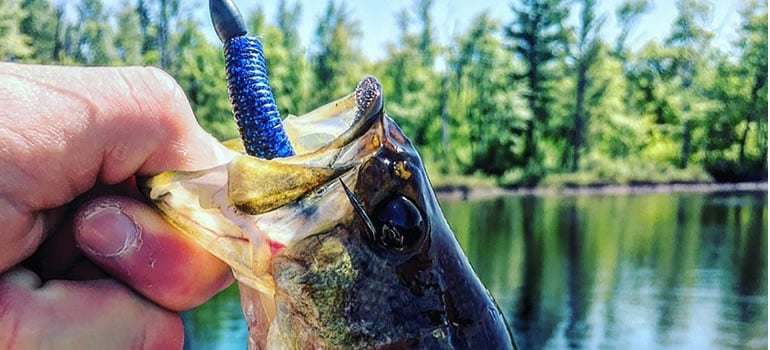
Any fisherman who goes after bass on the regular will tell you that bass will strike at worm baits readily, but do bass actually eat worms?
The truth is that in the wild, the bass would rarely have the opportunity to eat an earthworm, since basses are aquatic creatures and worms are subterranean creatures. This means they’d never seen an earthworm in the wild in most cases.
Rather than being attracted to worms as a source of food, the bass is attracted to striking worms because of the worm’s color and movement in the water. A worm that is submerged in a lake will begin to suffocate and will begin to wriggle in an attempt to remove itself from the water.
Bass see this wriggling movement and are tempted to attack it since, in their world flailing, movements mean weakness in small prey and a potential meal.
Why Worms Are Good for Catching Bass
The good thing about fishing for bass is that they aren’t just motivated by hunger–bass will strike anything in their immediate area as long as it catches their eye.
This is one of the reasons worms are so good for catching bass–the organic movements of a wriggling worm (either a live hooked worm or a plastic lure) are almost irresistible to a resting bass who sees them whether the bass is hungry or not.
Even in pitch blackness, the bass is capable of using their lateral lines to sense where moving objects are in the water, and this means that even if they can’t see the worm lure near them, they will sense the water displaced by it.
How to Rig a Worm Lure for Bass
Plastic worm lures are one of the most popular lures used on bass, largemouth bass in particular. These cheap lures come in a wide variety of colors, including some glitter-infused varieties and worms that are soaked in attractants.
This extra scent baiting might be effective for more scent-based hunters such as catfish, but for sight-based hunters like bass, the most important aspect of a worm lure is its movement and proximity to the fish.
Here is the process of rigging a soft plastic worm lure for bass fishing:
- Stab the point of the hook into the nose of the plastic worm lure. Run the hook in a fourth of an inch and then poke it out of the worm’s side at a ninety-degree angle.
- Run the hook out the side of the plastic worm lure until you get to the hook eyelet.
- Rotate the hook so that it is pointed back toward the lure body.
- Lay the hook to the side of the lure, keeping the worm straight.
- Thread the hook point into the body of the worm where the hook bend intersects the bottom of the worm.
This rig is also known as a Texas rig, and if performed correctly will prevent the lure from being snagged on weeds and other underwater structures. This lure can also be rigged with a sinker to drag it along the bottom and attract the attention of lazy lunker bass settled in deep water.
Because bass is often found in heavy cover and near underwater structures, setting up a bass rig to avoid snag-ups is crucial to making the most of your bass fishing time. This setup is a good choice for bass fishing around underwater brush, docks, submerged grass, or fallen trees.
How to Rig a Live Worm for Bass
Another option for bass fishing other than using plastic lures is to use live worm bait. Despite their inexperience with worms in the wild, large bass will strike enthusiastically at live worms. An advantage of using live worms as bait is that smaller fish are less likely to strike at them, which means if you get a bite, it’s likely a big one.
When bringing live worms as bait on a bass fishing trip, it’s important to keep the worms cool in a cooler filled with earth. Worms live underground and are sensitive to heat. Keeping worms cool also means they’ll wriggle less while you’re trying to put them on the hook. Here are some more tips on how to rig your fishing line with a live worm:
- Rub your hands in the dirt. This helps keep human scent off the bait and also makes the worm less slippery when you’re trying to spear it onto the hook.
- If you’re using a large worm, consider cutting it in half. Some earthworms sold as fish bait are true whoppers, and some of the might be intimidating in size to smaller bass. If you’re wanting to attract medium-sized bass as well as the biggest bass, chop your worms in half before hooking them.
- Hook the worm and run it up the hook until it’s at the top. Leave part of the worm dangling so that it can attract the fish with its movements.
- For small worms, use more than one. Manure worms and mealworms are small, so use a bunch to make sure the hook remains hidden.
- Check your worm bait often. Every ten or fifteen minutes, reel in and check your worm to see if it’s still on the hook and replace it if it’s not. No point in leaving a rig in the water with no bait on it!
Types of Worms to Catch Bass
There are two primary types of worms used to catch bass: plastic worm lures and live worms.
Live Worms
Live worms are used for fishing because they present both a scent and a sight lure to fish, who are attracted to their wriggling movements as well as their delicious fragrance in the water. There are many benefits of using live worms as bait for catching bass:
- Movement: Live worms move in the water on their own without having to be continually reeled for movement. The thrashing of a live worm speared on a hook is like ringing a dinner bell for nearby fish.
- Scent: Live worms provide an organic prey scent that attracts all kinds of fish to investigate the source. While some plastic lures have attracting chemicals added to them, they are hard-pressed to attract fish like fresh meat on the hook.
- Eco-friendly: Unlike lost plastic lures, lost worm lures won’t clutter up the natural environment with man-made trash, they’ll simply provide a tasty snack for somebody.
- Can raise your own worms for recreational use and profit: Raising worms for fish bait is easy and can also provide a source of worms for your garden compost. Raise enough of them and you can start a side hustle.
Do Hooked Worms Feel Pain?
Whether or not live worms feel pain when hooked on a lure has been a source of some controversy for many years and has kept many soft-hearted anglers from using them as bait, but the truth is that science has proven worms feel no pain when set on a hook.
This means that while live worms may wriggle on the hook to try to free themselves as a response to the stimuli of being caught on a hook, they do not suffer in the same sense that we perceive organisms with a developed central nervous system to suffer.
While no living creature wants to be eaten, worms are a vital part of the food chain and are taken as prey by many different creatures, including fish when they can get them. Since they don’t feel pain, live worms are just as appropriate to use for bass fishing as plastic ones.
Types of Live Worms
There are several different kinds of live worms used for fishing bait:
- Earthworms/nightcrawlers (Lumbricus terrestris): These worms are what we refer to when we talk about the common earthworm and can be found easily and widely distributed across the world.
- Red Wigglers (Eisenia fetida): These worms, also known as trout worms, are a popular choice among anglers. These worms are also prized by gardeners for their superior composting abilities.
- Mealworms (Tenebrio molitor): While not typically recommended for bass fishing, mealworms are used as a variety of live worm bait for smaller fish such as trout, bluegill, and perch.
Plastic Worms
Another option other than using live worms as bait is to consider plastic worm lures. There are many advantages of plastic lures over live worms, including some of the following:
- Durability: Unlike live worms, plastic lures will last in your tackle box indefinitely between fishing trips, making them a great choice for those who don’t get to go fishing on a regular basis.
- Humane: While it has been established by science that hooking worms does not cause them physical pain due to their lack of a central nervous system, the act of using any live bait can be distasteful to some anglers. Using plastic lures removes that aspect of the art of fishing and makes it more palatable for some people.
- Variety: All live worms pretty much look the same, but plastic worm lures come in an appealing variety of shapes, sizes, and colors to suit any fisherman’s aesthetic taste.
- Collectible: Lures are fishing equipment that can be collected and passed on to younger generations of fishermen.
- Less worry about snags: Unlike live worms, a plastic worm won’t manage to wriggle off the hook, and the thickness of the plastic means that with a rig that hides the hook point like a Texas rig, you can more easily avoid hang-ups than with a live worm setup.
Plastic Worms for Bass Fishing
Plastic worms themselves are very attractive to nearby fish when rigged on a lure, but the way a fisherman uses plastic worms while fishing is as much a factor in his success as the lure itself is. Since plastic worms lack the constant organic movement of a live worm on the hook, the fisherman must reproduce these kinds of movements himself.
Here are some tips for how to more effectively use a plastic worm for bass fishing:
- Fall rate has a big impact on strike rate: The speed at which a lure sinks to the bottom of a body of water is one of the largest influences on whether a bass strikes at the lure or not. If a bass gets too close of a look at the lure before deciding to strike, he will not go after it.
- Adjusting fall rate: Slower sinks (with smaller weights) should be used in murky water, and quicker sinks (with larger weights) should be used in clear water. Heavier weights are also advisable for windy fishing conditions.
- Hop your lure: Many bass fishermen are taught learning to fish that they should drag the lure, reel it in a bit, then drag it again. A better option for covering large swathes of water quickly is hopping the lure. This can increase your casting speed while also helping to tell you where the fish are positioned.
- With hooks, bigger isn’t always better: Many novice bass fishermen try to use very large hooks with plastic worm lures, but this isn’t necessary and in some cases, can even prevent a strike from landing. With most standard-sized plastic worm lures, a number four hook works just fine.
- Watch your line: When a bass takes a plastic worm, there isn’t always a large tug or indication that the bait has been taken. That means you have to be conscious of every vibration on the line and be sure to set the hook if you suspect a bite.
How to Source Live Worms for Bass Fishing
If you decide to go with live worms for bass fishing rather than plastic worms, these worms can be sourced in a variety of different ways:
- Bait shops: Most major bodies of water will have their share of local bait shops, and these bait shops will often carry either red wigglers or earthworms specifically for fishing. This is a convenient option, but the downside is that you’ll have to pay for this convenience,
- Foraging: Especially after heavy rains, earthworms can be found very easily in most places by overturning landscaping timbers, large stones, and fallen tree trunks. After setting up a cooler of the earth to collect them in, simply digging a shovel down a few feet in a garden or flower bed should yield plenty of earthworms.
- Vermiculture: A very cost-effective way to bass fish with worms is to raise earthworms or red worms yourself. This is accomplished by constructing a simple vermiculture bin (similar to a compost bin, but with living worms housed within). If kept correctly, the worms will multiply indefinitely and can be housed comfortably until used for fishing.
Raising Worms for Catching Bass
One of the easiest ways to set up a constant supply of live worm bait for your bass fishing adventures is to invest in vermiculture or the breeding of worms by setting up a simple worm bin. With just a few household materials, these bins can be constructed and used every season to keep a supply of fresh live worms on hand for both fishing and garden use.
Worm bins can either be bought prefabricated or can be built out of plastic storage bins with some holes drilled in them, as shown in this guide provided by the Environmental Protection Agency.
Once you have a worm bin, you can feed the worms in the bin using household fruit and vegetable scraps, tea bags, coffee grounds, bread, and dry cereal. Note: Animal by-products such as meat, dairy, and organic fats should not be introduced to a worm bin, as these will spoil and cause an offensive smell.
After establishing a worm bin, anglers need only dig around in the bin and select some worms to take with them on their next fishing trip. Provided the worm bin is kept in good condition and the worms are fed regularly, they will readily multiply and provide bait for months to come.
Bass Fishing and Worms—A Sure Fire Bet
It’s not hard to see why worms (both the plastic and live varieties) have remained such a popular bait favorite among hardcore anglers for decades.
While the advances in lure technology have led to a wide variety of plastic worms that are proven to drive high strike rates, it can be very cost-effective and rewarding to use live worms as well. Either way, bass fishing with worms are sure to land more than its fair share of whoppers.

